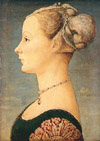|
|
Apartments in Florence, Perugia, Rome, Sorrento and Positano |




|
|
|
|
- You are in: Home » Tuscany » Siena
VISIT SIENA
« All the regions
PIAZZA DEL CAMPO
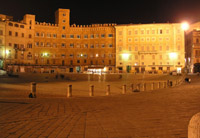
Piazza del Campo is in the center of Siena is its premier square. The piazza is shell shaped, symbolically uniting the different levels formed by the conjunction of the three hills on which the city was founded. Paved in red brick and marble, the site was built in the XIII century and is one of Europe's greatest medieval squares. It contains the Palazzo Pubblico and the Torre del Mangia. The XV century Gaia fountain (Fountain of Joy) is a center of attraction for the many tourists. It replaced the original fountain with a statue of the goddess Venus. This pagan statue was blamed for an outbreak of the Black Plague. The statue was destroyed and buried outside the city walls to avert its "evil influence". The present fountain in the shape of a rectangular basin was designed and built in white marble by Jacopo della Quercia. It is adorned on three sides with many statues, with the Madonna in the middle, surrounded by the Virtues. The old statues were replaced by copies in the 1860's. The bi-annual famous Palio is held in the square.
top
CATHEDRAL OF SIENA
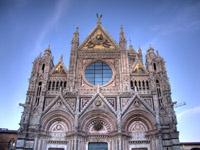
Piazza del Duomo is dominated by the imposing structure of Siena’s cathedral, dedicated to Santa Maria Assunta. Construction of the existing Duomo started in 1200, with the main sections already completed by 1215. The dome was built between 1259 and 1264. The Latin cross design of the church includes three naves and is entirely sheathed in strips of alternating black and white marble. The lower section of the facade was built between 1284 and 1296, probably under the supervision of Giovanni Pisano. Construction of the so-called "Duomo Nuovo" was started in 1339, under the direction of Lando di Pietro. Its polychrome marble decoration contains a number of sculptures. The lower section is Gothic-Romanesque in design (by Giovanni Pisano), with three doors. The upper section is in late-gothic style and was designed by Giovanni di Cecco. The alternating white and black bell tower is Romanesque and rests on a previously existing tower. Six sided at its base, the cupola develops into twelve sides as it rises and is adorned with gilded statues of saints placed in the niches at its base. The asymmetrical canopy above is decorated with 42 figures of the patriarchs and prophets, painted at the end of the 15th century. In 1532 Baldassare Petruzzi completed the marble high altar, which is surmounted by a bronze tabernacle by Vecchietta (1467-1472). The vast stained glass window of the apse is by Duccio di Buoninsegna. To the left there is a masterpiece of gothic sculpture: an altar by Nicola and Giovanni Pisano (1266-68). On the same side is the Chapel of St John the Baptist, with a statue of the saint completed by Donatello in 1457. Immediately after the chapel is the grand entrance to the Piccolomini Library, founded in 1495 by Cardinal Francesco Todeschini Piccolomini (later Pope Pius III) to house the library of his uncle, Pope Pius II.
top
PUBLIC PALACE
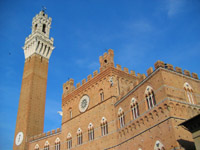
The Palazzo Pubblico (town hall) is a palace in the city of Siena. Construction began in 1297 and its original purpose was to house the republican government, consisting of the Podesta and Council of Nine. The outside of the structure is an example of Italian medieval architecture with Gothic influences. The lower story is stone; the upper crenelatted stories are made of brick. The facade of the palace is curved slightly inwards (concave) to reflect the outwards curve (convex) of the Piazza del Campo, Siena's central square of which the Palace is the focal point. The Campanile or bell tower, Torre del Mangia, was built between 1325 and 1344 with its crown designed by the painter, Lippo Memmi. The tower was designed to be taller than the tower in neighboring rival Florence; at the time it was the tallest structure in Italy. It was fitted with a mechanical clock during the mid 14th century. Nearly every major room in the palace contains frescoes. The most famous of the secular frescoes are three panels in the series on government in the Hall of the Nine (also known as Sala della Pace) by Ambrogio Lorenzetti These frescoes are collectively known as Allegory and Effects of Good and Bad Government. Many of the frescoes in the Palace are badly damaged. This is allegedly due to salt once stored in the basement of the building. It is theoretically possible that the salts wicked moisture down from the walls, causing the plaster to dry excessively and the frescoes to flake off.
top
PALIO
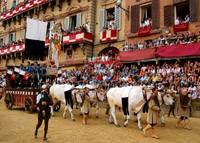
The second of July and the Sixteenth of August are the dates in which the "Palio" is held. The Palio is a traditional horse race which is conducted over a set course throughout the city each year. This event is attended by many tourists, and is widely televised. This event is not without its controversy however, and recently, there have been many complaints about the treatment of the horses. The race is a very dangerous one, as there are often a great deal of horses and riders packed into narrow streets, and rider death is not unheard of. In order to better protect the horses, steps have been made to make veterinary care more easily available during the race.
top
MANGIA TOWER
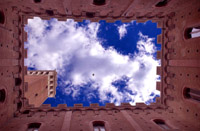
To the left of the Palazzo Pubblico rises the imposing Torre del Mangia, which to this day remains an arrestingly beautiful combination of height and elegant slightness of design. The curious name of the tower derives from its first bell ringer, Giovanni di Duccio, who was nicknamed Mangiaguadagni and who was commissioned to ring the hours in 1347. The tower’s foundation stone was laid in 1325, brought here with a solemn procession. The actual construction of the tower took place between 1338 and 1348, to designs by the Perugia-born architects Muccio and Francesco Di Rinaldo. Entirely in brick, the tower is surmounted by a stone bell chamber at its summit, possibly designed by Lippo Memmi. The top of the tower, which is 88 metres high and can be reached by mounting exactly 400 steps, commands magnificent views over the city and the surrounding countryside.
top
CHURCH OF OSSERVANZA

The Church of the Osservanza stands about two and a half kilometres outside Porta Ovile. The entire complex was originally built thanks to St Bernardino of Siena in the 15th century and is still one of Siena’s most important religious buildings. Successively the complex was enlarged and modified by the architect Giorgio Martini. Following severe damage during a bomb raid in 1944, the church was rebuilt according to the original design. The facade is simple, preceded only by a portico with a slanting roof. A high dome surmounts the church itself. The glazed terracotta medallions on the archway are by Andrea della Robbia (between 1425 and 1435). On the first altar to the left and in the third altar to the right there are two Madonnas by Sano di Pietro. The elegant polychrome terracotta sculpture of the Pietà is by Giacomo Cozzarelli (1435-1515).
The right hand wall of the fourth chapel is adorned with the Polyptich by Andrea di Bartolo, while in the second chapel there is a terracotta sculpture of the Coronation of the Virgin, by Andrea della Robbia. The Museo Aurelio Castelli is adjacent to the church, in the former Sacristy, and contains a collection of religious art and furnishings all belonging to the church itself.
top
|
|
|
|
|
|
| TOP DESTINATIONS
|
| Adria Coast, Aeolian Islands, Alessandria, Altopiano Delle Rocche, Amalfi Coast, Aosta, Assisi, Asti, Bari, Brescia, Capo Vaticano, Capri, Catanzaro, Chianti, Cilento, Cinque Terre, Coast Of Marche, Conero Coast, Dolomites, Egadi Islands, Elba, Florence, Garda Lake, Gargano, Ischia, Italian Riviera, Lake Como , Langhe Piedmont, Lecce, Lucca, Lunigiana, Macerata, Mantova, Maremma Tuscany, Monferrato, Montepulciano, Naples, Perugia, Pesaro Urbino, Pisa, Pistoia, Positano, Prato, Procida, Riviera Of Palms, Rome, Salento Coast, Salerno, San Gimignano, Sardinia, Sicily, Siena, Sorrento, Terni, Tiber Valley Of Tuscany, Treviso, Turin, Val Gandino, Veneto, Venice, Viterbo |
|
|









